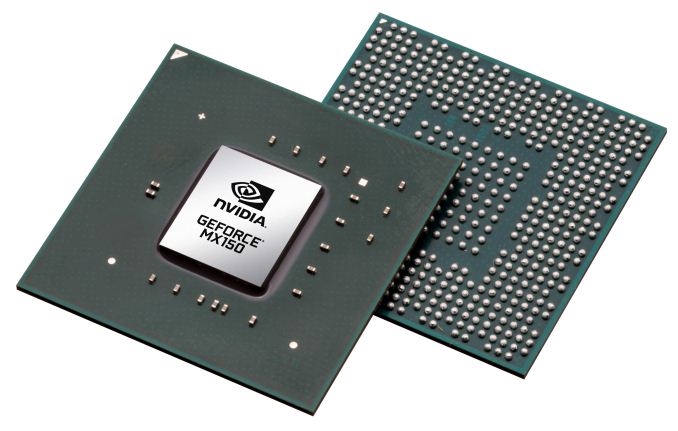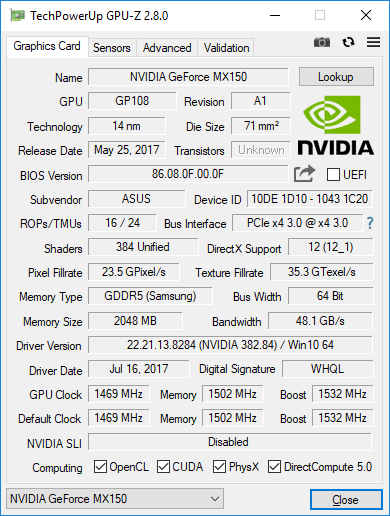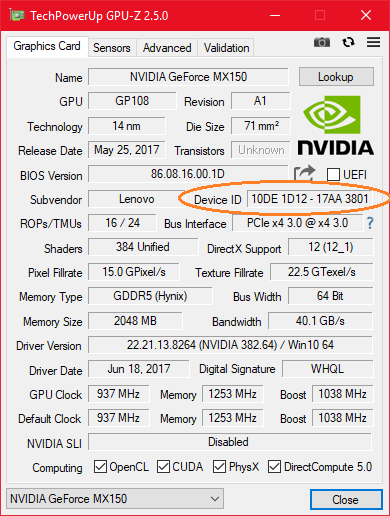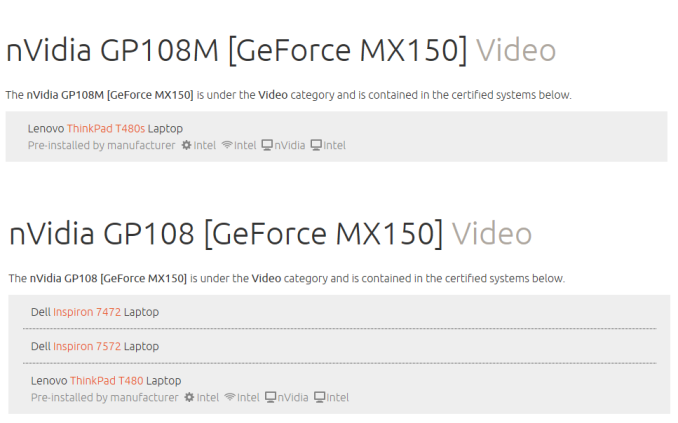NVIDIA Silently Rolls Out Slower, Lower TDP GeForce MX150 for Ultrabooks
by Nate Oh on March 23, 2018 2:00 PM EST
This week, Notebookcheck reported their findings of a second version of the GeForce MX150 – the newest version sporting lower base, boost, and memory clockspeeds versus the original SKU. Annoyingly however, these two versions are not being differentiated in advertising by NVIDIA or by OEMs.
Diving into matters, it looks like this second MX150 is designed to be a lower performing, lower TDP version for smaller ultrabooks. Notebookcheck cited their GPU-Z results as showing two different PCI IDs, comparing the standard ‘1D10’ and variant ‘1D12’ to find a default clockspeed difference of 36% for base, 17% for memory, and 32% for boost. In turn, they cited 3DMark tests in estimating a 20 to 25% performance drop for the “1D12’ MX150, where a number of 13 inch ultrabooks had this variant but was not disclosed.

 Notebookcheck's GPU-Z reports, with standard '1D10' N17S-G1-A1 GeForce MX150 in the Zenbook UX430UN (left), and slower '1D12' N17S-LG-A1 GeForce MX150 in the IdeaPad 320s-13kbr (right)
Notebookcheck's GPU-Z reports, with standard '1D10' N17S-G1-A1 GeForce MX150 in the Zenbook UX430UN (left), and slower '1D12' N17S-LG-A1 GeForce MX150 in the IdeaPad 320s-13kbr (right)
Further investigation on our part does reveal that there is a documented understanding that they are different parts, at least from an OEM perspective. By way of the official Ubuntu Certified hardware database, PCI ID ‘1D10’ is documented as the ‘GP108’ MX150 variant of the ThinkPad T480, while ‘1D12’ is recorded as the ‘GP108M’ variant of the ThinkPad T480s. In this case, although ‘GP108’ and ‘GP108M’ may not be NVIDIA’s own terminology, the Ubuntu Certified process involves OEMs directly working with Canonical to test their hardware. Canonical’s differentiation strongly implies that the OEMs are aware of MX150 variant.
Continuing with the ThinkPad as the prime case study, each product page has no indication of any difference in discrete graphics adapters, though the T480s is the thinner laptop variant. And while different cooling designs of laptops will change the exact clocks of the same GPU, the different PCI IDs and certifications suggest that this a vendor-side variant undisclosed to consumers.
In total, Notebookcheck also noted the presence of the slower MX150 in the ZenBook UX331UN, ZenBook UX331UA, Mi Notebook Air 13.3, Envy 13, and IdeaPad 320s. And a cursory look at The PCI ID Repository again corroborates the idea of the two corresponding ‘1D10’ and ‘1D12’ PCI IDs, with a GP108 Quadro variant in the P500. From the January/February dates of the Ubuntu certification and PCI ID Repository entries, we can say this development has been ongoing for several months at the least.
The engineering practicality isn’t in doubt here – constrained cooling designs of ultra-thin laptops necessitate lower discrete GPU clocks – but it appears that consumers were not notified of an explicit product difference. This is as juxtaposed with the OEM situation, where OEMs and/or NVIDIA did explicitly communicate to Canonical for the purposes of Ubuntu hardware certification. And while it is true that mobile and low-end (and especially mobile low-end) GPUs receive very little in terms of public documentation or vendor disclosure, this is why a lack of product transparency is a losing situation all around.
Though we only came across the Ubuntu Certified database entries after reaching out, NVIDIA has declined to comment on the matter. However, with what we have collated, there seems to be little reason to doubt the undisclosed slower MX150 variant.











40 Comments
View All Comments
Samus - Saturday, March 24, 2018 - link
True. Typical Lenovo scam here. They should clearly market the product with the stated clock speeds.Xaguoc - Saturday, March 24, 2018 - link
NVIDIA's 860M is a prime example. It came with variations of DDR3, GDDR3 and GDDR5 VRAM. Oh and 2/4GB versions on top of the VRAM lottery.Vayra - Sunday, March 25, 2018 - link
Yes, and LO AND BEHOLD, the Nvidia specs page actually has infohttps://www.geforce.com/hardware/notebook-gpus/gef...
Now look at the MX150's
https://www.geforce.com/hardware/notebook-gpus/gef...
vithrell - Monday, March 26, 2018 - link
Under 860m name was hiding one of chips from DIFFERENT ARCHITECTURES: Maxwell GM107 or Kepler GK104 with almost two-fold difference in TDP and unified shaders count.https://en.wikipedia.org/wiki/List_of_Nvidia_graph...
Alexvrb - Sunday, March 25, 2018 - link
It's not new but it the fact that they've been doing this crap for years doesn't make it cool. I hated it then, I hate it now. Second, the RAM type was usually better documented in the specs - not that this helped your average consumer in the way that a higher or lower model designation would.Anonymous Blowhard - Friday, March 23, 2018 - link
I imagine that a 30% haircut in performance is justification enough - in the EU at least, where consumer protection laws exist - for a product return.The_Assimilator - Friday, March 23, 2018 - link
It seems like the ROP/TMU/shader counts are identical between the two, so my question would be - can the lower-clocked version be overclocked to the same levels as the "ordinary" version? Because if it can, this isn't really a different product, it's the same product with a slower/more energy-efficient BIOS.OTOH, if the GPUs and GDDR5 aren't capable of reaching the same clocks, then yes I would class these as distinct products, and they should be named accordingly.
watzupken - Saturday, March 24, 2018 - link
While specs wise is the same, it may be possible to OC it to the original clockspeed. However, I said may be because Nvidia always impose a clockspeed lock, I.e. Either completely locked or it only allows you to OC up to a certain clockspeed.Anyway, any changes in specs should be clearly conveyed to customers. I believe both Nvidia and AMD are guilty of such shady practice. If the name does not clearly highlight a difference, they are selling a product that is not just different, but also worst. If they are changing the specs to make it faster, I believe people will welcome it. But it is never the case where the product of the same model gets a spec bump for free,
Ej24 - Friday, March 23, 2018 - link
They already have a mx130... It probably has about the same performance and power draw. This will only confuse consumers as to what performance they can really expect.SquarePeg - Friday, March 23, 2018 - link
Would it have killed them to show a bit of honesty and just labeled this GPU as the MX140. Nvidia is trying really hard to be the dishonest Intel of 15 years ago.